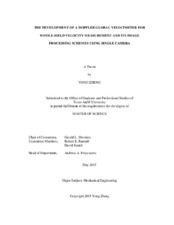| dc.description.abstract | In this study, the development of a Doppler Global Velocimetry (DGV) system using single high speed camera including both hardware and data reduction software is described. DGV is an emerging technique for whole field velocity measurement based upon the Doppler frequency shift of the light scattered by the seeded particles in the flow field. Determination of the Doppler shift is achieved by applying a frequency-to-intensity image conversion in the form of an Absorption Line Filter (ALF) cell containing iodine vapor inside the cell. The Doppler frequency shift of the light scattered by the moving seed particles is then employed to calculate the velocity of the moving particles. Using light sheet generated by applying a set of optics and the laser source and imaging optics, the DGV measures the global velocity of a two-dimensional section of the seeded jet flow.
Based upon the DGV system first developed by C. Gaharan [1] in 1996, this study describes a simplified optical system and corresponding data reduction code developments in Matlab. A new laser light source, single lens imaging optical system and a single high speed camera (Phantom V711, Vision Research Inc.) are the main modifications on the hardware. For the previous DGV system developed by C. Gaharan [1], two separate cameras were required for simultaneously recording ALF and REF images of the flow field, while the simplified imaging optical system in this study is able to record both the ALF and REF images on the same screen, which makes applying a single camera adequate to capture the data images required for data reduction and speed calculation without having to sync the capturing operation between separate cameras. An integrated LabView code and a Matlab data reduction code were developed to perform the functions of spatial calibration, intensity calibration, ALF cell calibration, speed calibration and velocity calculation.
The system is tested by measuring the surface speed across a 99.06 mm diameter white disc rotating at varied speed from 6000 rpm to 18000 rpm under selected transmission ratios of the ALF cell, as well as a 12.7mm diameter free-expansion turbulent jet operating at a primary Mach number of 0.15.
In the DGV system, telecentric lens is applied between the test plane area and the imaging optical system to eliminate the image distortions on the edge area of the lens. In this study, 0.16X Techspec Silver Series Telecentric Lens and 0.06X Gold Series Telecentric Lens are respectively applied, the 0.06X telecentric allows over 6.25 times the light of 0.16X telecentric lens to be collected and recorded by the high speed Phantom camera, corresponding difference resulting from this two telecentric lens is quantified. | en |


